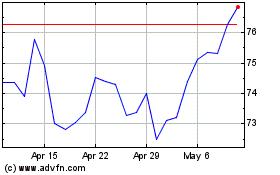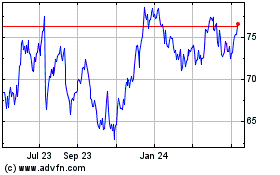State Street Provides Mid-Year Update on Business Operations and IT Transformation Program
July 19 2011 - 9:05AM
Business Wire
State Street Corporation (NYSE: STT), one of the world’s leading
providers of financial services to institutional investors, today
provided an update of its multi-year business operations and IT
transformation program. First announced in November 2010, the
program is designed to enhance State Street’s growth by
substantially increasing its focus on technology research and
development and service excellence to drive innovation for clients
and to streamline its operating model.
In step with the program, which is expected to be completed in
2014, the company will expand its longstanding relationships with
IBM and Wipro Technologies (Wipro) to support components of its
technology infrastructure and application maintenance and support
systems. IBM is a global leader in business and technology services
with expertise in the financial services industry, and Wipro is a
leading global information technology and consulting company that
specializes in IT solutions and services. By expanding its
relationships with two established industry leaders that specialize
in IT support services, State Street can increase the efficiency
and effectiveness of its overall IT operation. State Street’s
internal IT resources will be more focused on research and
development, including further use of innovations such as
private-cloud computing that will create more sophisticated,
client-facing solutions and services.
As part of this program, approximately 320 non-client facing
State Street IT employees will transition to IBM or Wipro and
another approximately 530 non-client facing IT employees will be
provided with severance and outplacement services as their roles
are eliminated over the course of the next 18-20 months. Nearly all
of the impacted employees are located in North America. State
Street currently employs approximately 4,000 IT employees
worldwide.
“Our business operations and IT transformation program reflects
our commitment to maintaining an advantage that supports our
continued growth in an increasingly competitive global
environment,” said James S. Phalen, executive vice president and
head of Global Operations, Technology and Product Development.
“While making changes that impact a number of our employees is
never easy, we believe that this move is a necessary step that will
allow us to better deploy our resources in line with our core
competencies, efficiently leverage the capabilities of our
partners, and enable us to offer more sophisticated products and
services to our clients.”
As announced on November 30, 2010, State Street expects to
achieve annual pre-tax run-rate expense savings from its business
transformation initiatives of between $575 million and $625 million
by the end of 2014 and to record pre-tax restructuring charges of
between $400 million to $450 million in total over the four-year
period. The Company expects to record approximately $110 million to
$130 million of those pre-tax restructuring charges in the second
half of 2011 to accrue for the severance and related costs
associated with workforce reduction and other transition costs as a
result of the company’s expanded technology relationships described
above.
State Street Corporation (NYSE: STT) is the world's leading
provider of financial services to institutional investors including
investment servicing, investment management and investment research
and trading. With $22.762 trillion in assets under custody and
administration and $2.116 trillion* in assets under management at
June 30, 2011, State Street operates in 26 countries and more than
100 geographic markets and employs 29,450 worldwide. For more
information, visit State Street’s web site at www.statestreet.com
or call +1 877/639-7788 [NEWS STT] toll-free in the United States
and Canada, or +1 678/999-4577 outside those countries.
*This AUM includes the assets of the SPDR Gold Trust (approx.
$58 billion as of June 30, 2011), for which State Street Global
Markets, LLC, an affiliate of State Street Global Advisors, serves
as the marketing agent.
Forward-Looking Statements
This news release contains forward-looking statements as defined
by United States securities laws, including statements relating to
our goals and expectations regarding our multi-year business
transformation program and the financial, operational,
technological, customer and other business effects and strategies
of that program. Forward-looking statements are often identified by
such forward-looking terminology as "plan," "expect," "look,"
"believe," "anticipate," "estimate," "seek," "may," "will,"
"trend," "target," and "goal," or similar statements or variations
of such terms. These statements are not guarantees of future
performance, are inherently uncertain, are based on current
assumptions that are difficult to predict and involve a number of
risks and uncertainties. Therefore, actual outcomes and results may
differ materially from what is expressed in those statements, and
those statements should not be relied upon as representing our
expectations or beliefs as of any date subsequent to July 19,
2011.
Important factors that may affect future results and outcomes
include, but are not limited to:
- delays or difficulties in the execution
of our multi-year business operations and IT transformation
program, which could lead to changes in our estimates of the
charges, expenses or savings associated with the planned program,
resulting in increased volatility of our earnings, or which could
limit the anticipated benefits of the program;
- our ability to control operating risks,
data security breach risks, information technology systems risks
and outsourcing risks, and our ability to protect our intellectual
property rights, the possibility of errors in the quantitative
models we use to manage our business and the possibility that our
controls will prove insufficient, fail or be circumvented;
- the manner in which the Federal Reserve
and other regulators implement the Dodd-Frank Act and other
regulatory initiatives in the U.S. and internationally, including
any increases in the minimum regulatory capital ratios applicable
to us and regulatory developments that result in changes to our
operating model, or other changes to the provision of our services
in order to comply with or respond to such regulations;
- required regulatory capital ratios
under Basel II and Basel III, in each case as fully implemented by
State Street and State Street Bank (and in the case of Basel III,
when finally adopted by the Federal Reserve), which may result in
the need for substantial additional capital or increased levels of
liquidity in the future;
- changes in law or regulation that may
adversely affect our, our clients’ or our counterparties’ business
activities and the products or services that we sell, including
additional or increased taxes or assessments thereon, capital
adequacy requirements and changes that expose us to risks related
to compliance;
- financial market disruptions and the
economic recession, whether in the U.S. or internationally;
- the liquidity of the U.S. and
international securities markets, particularly the markets for
fixed-income securities, and the liquidity requirements of our
clients;
- increases in the volatility of, or
declines in the levels of, our net interest revenue, changes in the
composition of the assets carried in our consolidated statement of
condition and the possibility that we may be required to change the
manner in which we fund those assets;
- the financial strength and continuing
viability of the counterparties with which we or our clients do
business and to which we have investment, credit or financial
exposure;
- the credit quality, credit agency
ratings, and fair values of the securities in our investment
securities portfolio, a deterioration or downgrade of which could
lead to other-than-temporary impairment of the respective
securities and the recognition of an impairment loss in our
consolidated statement of income;
- the maintenance of credit agency
ratings for our debt and depository obligations as well as the
level of credibility of credit agency ratings;
- the risks that acquired businesses will
not be integrated successfully, or that the integration will take
longer than anticipated, that expected synergies will not be
achieved or unexpected disynergies will be experienced, that client
and deposit retention goals will not be met, that other regulatory
or operational challenges will be experienced and that disruptions
from the transaction will harm relationships with clients,
employees or regulators;
- the ability to complete acquisitions,
divestitures and joint ventures, including the ability to obtain
regulatory approvals, the ability to arrange financing as required
and the ability to satisfy closing conditions;
- the performance of and demand for the
products and services we offer, including the level and timing of
redemptions and withdrawals from our collateral pools and other
collective investment products;
- the possibility that our clients will
incur substantial losses in investment pools where we act as agent,
and the possibility of significant reductions in the valuation of
assets;
- our ability to attract deposits and
other low-cost, short-term funding;
- potential changes to the competitive
environment, including changes due to the effects of consolidation,
and perceptions of State Street as a suitable service provider or
counterparty;
- the level and volatility of interest
rates and the performance and volatility of securities, credit,
currency and other markets in the U.S. and internationally;
- our ability to measure the fair value
of the investment securities carried in our consolidated statement
of condition;
- the results of litigation, government
investigations and similar disputes or proceedings;
- adverse publicity or other reputational
harm;
- our ability to grow revenue, attract
and/or retain and compensate highly skilled people, control
expenses and attract the capital necessary to achieve our business
goals and comply with regulatory requirements;
- the potential for new products and
services to impose additional costs on us and expose us to
increased operational risk;
- changes in accounting standards and
practices; and
- changes in tax legislation and in the
interpretation of existing tax laws by U.S. and non-U.S. tax
authorities that affect the amount of taxes due.
Other important factors that could cause actual results to
differ materially from those indicated by any forward-looking
statements are set forth in our 2010 Annual Report on Form 10-K and
our subsequent SEC filings. We encourage investors to read these
filings, particularly the sections on risk factors, for additional
information with respect to any forward-looking statements and
prior to making any investment decision. The forward-looking
statements contained in this presentation speak only as of the date
hereof, July 19, 2011, and we do not undertake efforts to revise
those forward-looking statements to reflect events after that
date.
State Street (NYSE:STT)
Historical Stock Chart
From Jun 2024 to Jul 2024

State Street (NYSE:STT)
Historical Stock Chart
From Jul 2023 to Jul 2024
